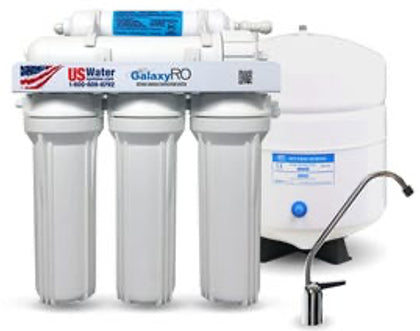How To Troubleshoot Your Undersink Reverse Osmosis System

Frequently Asked Question:
We just changed our whole reverse osmosis by buying a new tank and new filters and a membrane (supposedly made in the USA). The filters and membrane we bought now are the same as the ones used previously. The problem we have now is that the TDS measures high… way higher than the tap water we have, which usually measures between 159 and 162. Our reverse osmosis's TDS is now over 200. We had readings from 800+ to 150+ and now to over 200. The water tastes really good, though, like fresh. I grew up on the farm in eastern Europe, and we only drank fresh well water, so I know what fresh tastes like.
What could make the TDS numbers so high? Our reverse osmosis is a 5 -Stage as I don't see the point of adding all those expensive, extra filters that don't make any sense. We do have mineral drops that we could add to our water, but I concentrate on healthy food to get them from first.

Typical 5-Stage RO System
This is a common question that we get several times a week. I am going to list some things that can be a problem when changing your RO filters, although I think that #1 is likely your problem. Here is a list of issues that can impact your water quality when changing your filters and/membrane:
1. RECONNECT LINES PROPERLY: When you change the RO filters and/or membrane, sometimes you forget how to reconnect the tubing. I suggest taking pictures before you remove any tubing so that you can reconnect it back properly.
2. PUSH THE MEMBRANE ALL THE WAY IN: If you have a standard 5-Stage RO like the one pictured above when you disassemble the membrane housing and pull out the membrane (which you usually have to use pliers to do), frequently people fail to push the membrane in securely. There are two o-rings on the end where it gets pushed in. You should lubricate the o-rings with a light layer of silicone (which we include in our filter packs) - never use Vaseline as it will deteriorate the rubber o-rings. You can take a quarter and put it on the end of the membrane where you push it in.
3. THOROUGHLY RINSE THE SYSTEM: It is common to see cloudy water from carbon fines when changing the filters. I suggest letting the tank fill up and then open the faucet and let the water run until it stops. Repeat that two more times By the way, it may take several hours to fill the tank. Some people complain of air bubbles in the water. Air readily travels through an RO membrane, so if your water supply has a lot of air, you will see bubbles. They float the top and dissipate after a few seconds. Most people agree that dissolved oxygen makes water taste better.
4. NO WATER COMES THROUGH THE SYSTEM: Several things can cause this, including not turning the inlet valve or tank valve back on (duuuuhhhh!). Your flow restrictor (located at the drain line on the membrane) could be plugged. Always match your flow restrictor to your membrane size, and if you change membrane sizes (higher or lower GPD), make sure to match the flow control.
5. TAKE THE WRAPPING OFF THE FILTERS: As obvious as that sounds, a few people fail to perform this obvious task.
6. CHECK YOUR AUTO SHUTOFF VALVE (ASO): You can have it installed backwards if you removed the tubing or just in turning the water on-and-off, the diaphragm can tear. The ASO is easily replaced and can be found HERE.
7. CHECK THE TUBING:Over the years, the tubing can get scratched or scored. If it has a deep scratch, you should just cut it short with “John Guest Snips” or replace the tubing.

8. NO PRESSURE IN YOUR PRESSURE TANK: I advise replacing the tank every 5 years anyway, but if you have lost pressure, do not just add air. The air leaked out some way - just replace the tank as the odds are the bladder is bad.
9. SANITIZE THE SYSTEM: We have direction in our filter packs. Be sure and sanitize the system after each filter change. We also have lots of videos to help your troubleshoot and/or install the systems: https://www.uswatersystems.com/techsupport-ro
10. CONSIDER A OPERATION & MAINTENANCE KIT: Our kits have most of the things you need to replace or repair parts on your RO system. It can save you a lot of trouble later.
11. LEGENDARY TECHNICAL SUPPORT: If all else fails and you have exhausted the above tips, you can call us at 800-608-8792 and ask for our Legendary Technical Support. Did I mention that it is legendary?





16 Comments
No, I would not run the sanitizing solution through the post-filter.
Leave a comment
Please note, comments need to be approved before they are published.